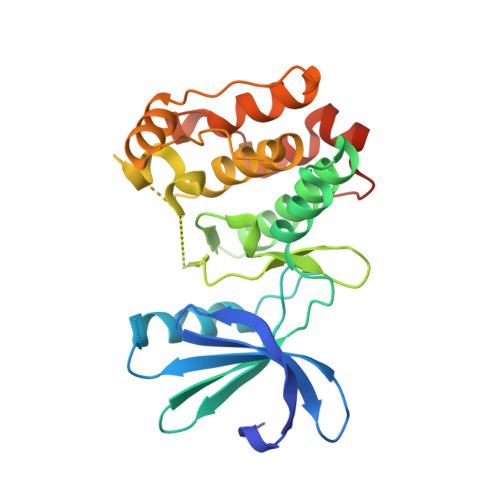Optimization of Imidazo[4,5-B]Pyridine-Based Kinase Inhibitors: Identification of a Dual Flt3/Aurora Kinase Inhibitor as an Orally Bioavailable Preclinical Development Candidate for the Treatment of Acute Myeloid Leukemia.
Bavetsias, V., Crumpler, S., Sun, C., Avery, S., Atrash, B., Faisal, A., Moore, A.S., Kosmopoulou, M., Brown, N., Sheldrake, P.W., Bush, K., Henley, A., Box, G., Valenti, M., De Haven Brandon, A., Raynaud, F.I., Workman, P., Eccles, S.A., Bayliss, R., Linardopoulos, S., Blagg, J.(2012) J Med Chem 55: 8721
- PubMed: 23043539
- DOI: https://doi.org/10.1021/jm300952s
- Primary Citation of Related Structures:
4B0G - PubMed Abstract:
Optimization of the imidazo[4,5-b]pyridine-based series of Aurora kinase inhibitors led to the identification of 6-chloro-7-(4-(4-chlorobenzyl)piperazin-1-yl)-2-(1,3-dimethyl-1H-pyrazol-4-yl)-3H-imidazo[4,5-b]pyridine (27e), a potent inhibitor of Aurora kinases (Aurora-A K(d) = 7.5 nM, Aurora-B K(d) = 48 nM), FLT3 kinase (K(d) = 6.2 nM), and FLT3 mutants including FLT3-ITD (K(d) = 38 nM) and FLT3(D835Y) (K(d) = 14 nM). FLT3-ITD causes constitutive FLT3 kinase activation and is detected in 20-35% of adults and 15% of children with acute myeloid leukemia (AML), conferring a poor prognosis in both age groups. In an in vivo setting, 27e strongly inhibited the growth of a FLT3-ITD-positive AML human tumor xenograft (MV4-11) following oral administration, with in vivo biomarker modulation and plasma free drug exposures consistent with dual FLT3 and Aurora kinase inhibition. Compound 27e, an orally bioavailable dual FLT3 and Aurora kinase inhibitor, was selected as a preclinical development candidate for the treatment of human malignancies, in particular AML, in adults and children.
Organizational Affiliation:
Cancer Research UK Cancer Therapeutics Unit, Division of Cancer Therapeutics, The Institute of Cancer Research, 15 Cotswold Road, Sutton, Surrey SM2 5NG, United Kingdom.
















